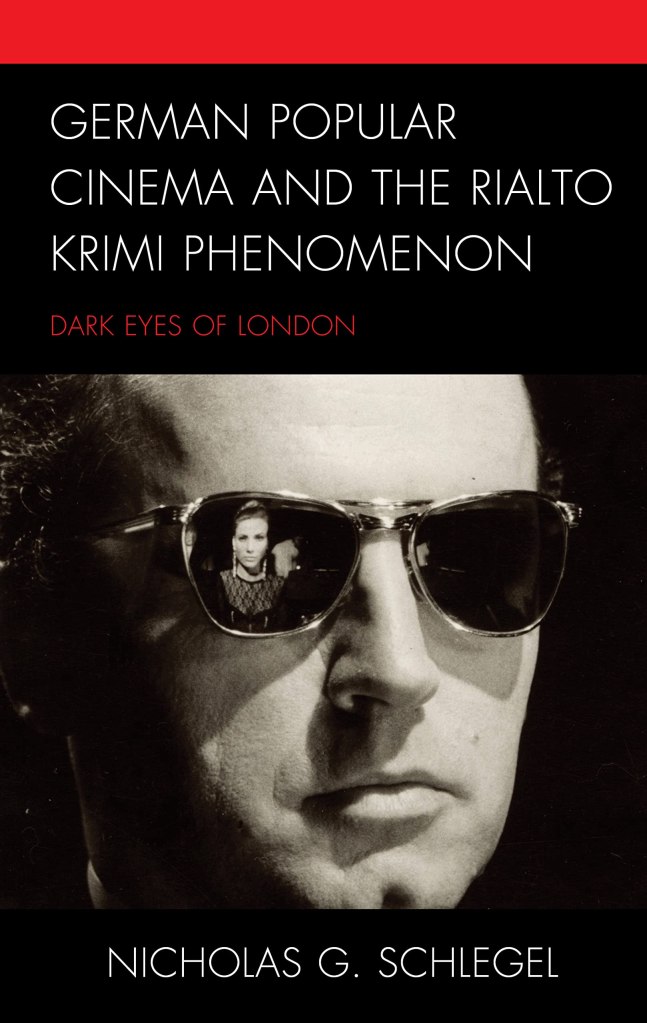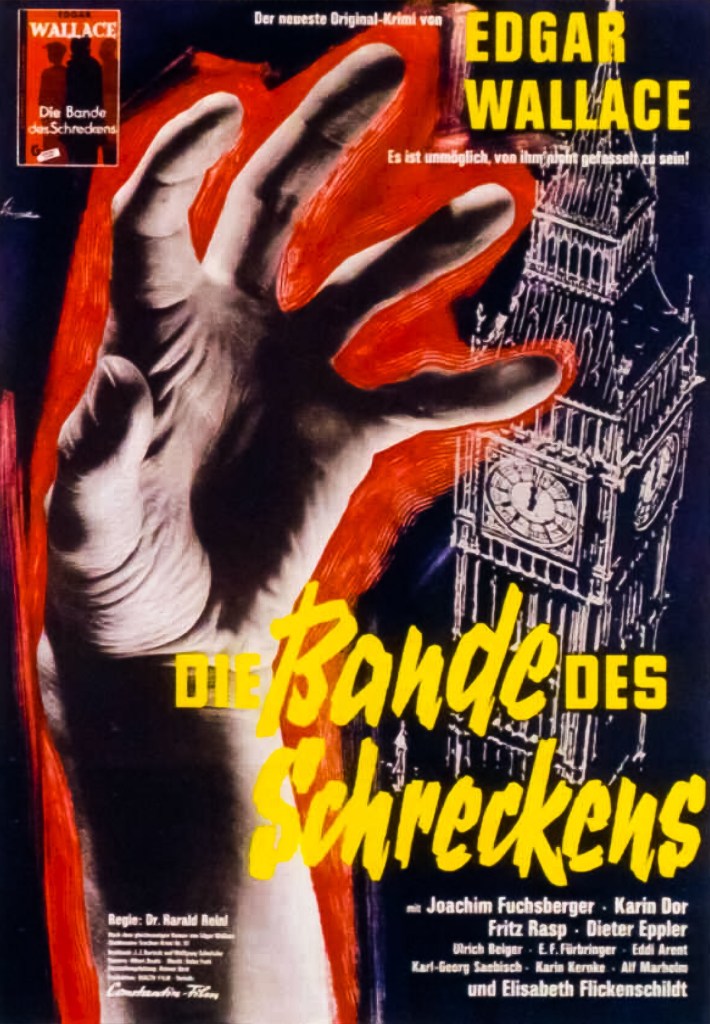German Popular Cinema and the Rialoto Phenomenon: Dark Eyes of London
by Nicholas G. Schlegel
Lexington Books
Hardback: 978-1-4985-7072-5 (US: $95 | UK: £73)
eBook: 978-1-4985-7073-2 (US: $45 | UK: £35)
Published: January 2022
Purchase book here

Once you start getting into cult films it’s a never-ending spiral down a very deep rabbit hole and it’s only up to you where to stop.
For a modern audience entry level can be as basic as some of the big Hollywood series like Halloween or Friday the 13th .
Get a historic perspective and you can easily reach the classic Hammer films or Universal Horror or maybe some of the rarer English language stuff.
Dig a bit deeper and you discover that there is literally a world of foreign material out there worth venturing into. How about Japan’s Godzilla movies or the Italian Giallo films? And if you stick to directors like Dario Argento or Mario Bava, their films these days may be niche enough to raise an eyebrow for the average cinema goer, but they are still easy enough to get a hold of.
However, if you dig even further you can find films that, though highly popular in their home countries, are virtually unknown abroad and never saw a decent DVD or Blu-ray release outside their native regions. The Rialto series of 32 German Krimis filmed between 1959-1972 and based on the works of Edgar Wallace certainly counts amongst those.
After that? How about some classic Malaysian or Philippino cult? As I said: The list is endless and at some stage information becomes rare and a reliable guide is needed.

Edgar Wallace may have been one of the most successful writers of his time. In the English-speaking world nowadays, however, he is mainly remembered (if at all) as the author of the first draft of King Kong (1933).
In Germany on the other hand his success has been ongoing and he is still a household name mainly due to a series of Krimis produced by Rialto that ended up being a tremendously popular franchise and that still get repeated regularly on German television.
“Krimis” in Germany is a word describing any kind of crime or mystery related book or movie. For foreign fans the term relates more specifically to those Edgar Wallace movies as well as a number of other similar copycat productions from Germany that were inspired by the reception of those Rialto films.
The series began in 1959 with Der Frosch mit der Maske/Fellowship of the Frog (aka Face of the Frog) and lasted until 1972’s Das Rätsel des silbernen Halbmonds/Seven Blood-Stained Orchids.
During that time they underwent various changes and evolved from black and white to colour productions. Initially the films were more closely based on the Edgar Wallace novels; towards the end they were Wallace by name only.
Whereas the early entries can be said to have inspired the Italian Giallo genre, the last ones outside of Germany are primarily known as Gialli and therefore can best be described as Krimi/Giallo hybrids. During their run a lot of those movies were co-productions with other countries such as Denmark, France, England or Italy.
Unless one has actually watched a Krimi, it is very difficult to describe what makes up their charm. They occupy a world all of their own: German mystery movies set in England with a very idiosyncratic view of British life with larger than life masked villains, large doses of humour and eccentricity and a heavy Gothic Horror atmosphere.
Nicholas G. Schlegel’s German Popular Cinema and the Rialto Phenomenon is the first standalone English language book fully dedicated to this series of Rialto Edgar Wallace Krimis.
In Germany there has been no shortage of books dedicated to those films including very richly illustrated coffee table tomes with detailed production info – but often with an over-reliance on contemporary reviews and missing a distinct modern authorial voice that would allow to place those films into a more historical background and highlight the attractions they still hold for a 21st century audience.
As such Schlegel’s book on more than one front provides a very welcome outside perspective.
Schlegel is an assistant professor of communication studies at Alfred University in Alfred, New York, who had previously penned a book on Sex, Sadism, Spain, and Cinema: The Spanish Horror Film.
He properly places the films into a post-war context starting with the Neo-realist “Trümmerfilme” (rubble films) that depicted a destroyed Germany, the rival approaches to film making in the East and West of Germany, and the subsequent success of shallow musical comedies and “Heimatfilme” (idyllic romances set in the German countryside) of the 1950s that helped the German public to escape from their daily worries.
Following the discussion of the Rialto series he also offers a welcome look at how those cinematic Krimis evolved further into classic German Crime TV from the 1970s on – shows that again are virtually unknown in the English-speaking world but that often were popular in Continental Europe and provided employment for some of the talent in front of and behind the camera that had made the Krimis such a success.
In his film by film analysis of the 32 movies in question he manages to remain entirely spoiler free with regards to the final reveals – no mean feat given the often complex nature of the plots. Schlegel provides a wealth of info with the regards to the productions and the people involved, e.g. directors (Harald Reinl, Alfred Vohrer), writers (Herbert Reinecker) and actors (Joachim Fuchsberger, Karin Dor, Klaus Kinski, Eddi Arent, Heinz Drache to name but a few).
Though an academic publication, this is in no way a dry read. Schlegel always comes across as an enthusiastic fan of the genre but never a fanboy. His critical evaluation of the movies is always well argued and presented. Some photos help round this up and give a small idea of the imagery that the audience can expect from those productions.

There are some minor quibbles.
The abbreviations that Schlegel uses from time to time (e.g. “Bande Schreckens” for Die Bande des Schreckens/The Terrible People) can sound pretty crude to native German speakers as they seem to ignore basic German syntax or grammar. (Most English speakers, his intended readership, will likely not be too bothered.)
He also doesn’t seem to be a great fan Peter Thomas’ music which puts him somewhat at odds with general fandom, though it is refreshing to read well argued points against Thomas’ soundtracks.
Edgar Wallace’s son, Bryan Edgar Wallace, was also an author of mystery novels who was frequently adapted by German film studios attempting to recreate the success of the Rialto movies. Schlegel repeats the opinion several times that Bryan Edgar Wallace’s writing style was virtually indistinguishable from that of his father. Based on the reading of just one of his books (The Device) I actually find his style to be much more accessible for a modern readership and distinct enough from that of his father. Where it may become indistinguishable is in the adaptations which mainly required the use of his name (with an extra emphasis on the last two words in promotional material to confuse the audience) and were very often not even based on actual books by Wallace fils.
There are no Ifs and Buts about it though: This book IS expensive (official pricing: US$95/£73 for the hardcover, US$45/£35 for the Kindle ebook). This is an academic book and we could have lengthy discussions as to whether there really is a genuine business need for the kind of pricing those demand when other niche market publishers with equally small print runs manage to churn out stunning coffee table books for less.
It is what it is though and Nicholas Schlegel’s book ultimately is a an absolute Must Read for anyone even remotely interested in those Krimis… if they can afford it.
If all comes to all just try and get a loan from a public or university library.
Holger Haase
Review published: 7 November 2022

Nice, balanced review, Holger. I, too, think this to be an indispensable book for any krimi fan.
LikeLike